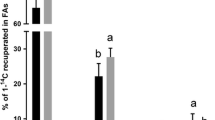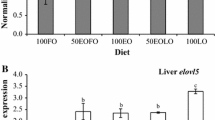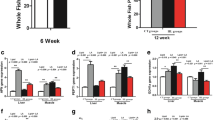Abstract
The meagre (Argyrosomus regius) is taking on increasing importance in the aquaculture industry. In view of the limited supply of fish oil (FO) as a feed ingredient, the study of the capacity to biosynthesize long-chain polyunsaturated fatty acids (LC-PUFA) from alternative dietary oil sources is important. We analyzed changes in fatty acid (FA) desaturase 2 (fads2) and FA elongase 5 (elovl5) mRNA levels in livers and brains in response to FO replacement with a blend of vegetable oils (VO) and selenium (Se) supplementation. Fish were fed for 60 days with either a diet containing FO or a diet including VO, each supplemented or not with organic Se. Results showed that fads2 and elovl5 transcription was higher in liver when fish were fed VO diets. The brain mRNA levels of both genes were not affected by the dietary replacement of FO by VO. FA composition in the liver and skeletal muscle was altered by FO replacement, particularly by decreasing eicosapentaenoic acid and docosahexaenoic acid contents. The α-linolenic, linoleic, and arachidonic acid contents increased in both liver and brain of fish fed VO diets. The effect of Se supplementation on lipid metabolism was evident only in fish fed FO, showing a decrease in the transcription of hepatic fads2. Results indicate that the total replacement of FO by VO in diets modulates the expression of genes involved in LC-PUFA biosynthesis in meagre, affecting the FA profile of the fish flesh.




Similar content being viewed by others
Abbreviations
- ALA:
-
α-Linolenic acid
- ARA:
-
Arachidonic acid
- DBI:
-
Double bond index
- DGI:
-
Daily growth index
- DHA:
-
Docosahexaenoic acid
- DPA:
-
Docosapentaenoic acid
- Elovl:
-
Elongase enzyme
- elovl5 :
-
Fatty acid elongase 5
- EPA:
-
Eicosapentaenoic acid
- FA:
-
Fatty acid
- Fads:
-
Desaturase enzyme
- fads2 :
-
Fatty acid desaturase 2
- FAS:
-
Fatty acid synthetase
- FE:
-
Feed efficiency
- FO:
-
Fish oil
- LNA:
-
Linoleic acid
- LC-PUFA:
-
Long-chain polyunsaturated fatty acids
- MUFA:
-
Monounsaturated fatty acids
- Se:
-
Selenium
- +Se:
-
With selenium
- −Se:
-
Without selenium
- SFA:
-
Saturated fatty acids
- VO:
-
Vegetable oils
- WG:
-
Weight gain
References
FAO (2012) The state of world fisheries and aquaculture. Food and Agricultural Organization of the United Nations, Rome, p 218
Geay F, Santigosa ICE, Corporeau C et al (2010) Regulation of FADS2 expression and activity in European sea bass (Dicentrarchus labrax, L.) fed a vegetable diet. Comp Biochem Physiol B Biochem Mol Biol 156(4):237–243
Piedecausa MA, Mazón MJ, García García B et al (2007) Effects of total replacement of fish oil by vegetable oils in the diets of sharpsnout seabream (Diplodus puntazzo). Aquaculture 263(1–4):211–219
Tocher DR (2003) Metabolism and functions of lipids and fatty acids in teleost fish. Rev Fish Sci 11(2):107–184
Leaver MJ, Bautista JM, Björnsson BT et al (2008) Towards fish lipid nutrigenomics: current state and prospects for fin-fish aquaculture. Rev Fish Sci 16(S1):73–94
Castro LFC, Monroig O, Leaver MJ et al (2012) Functional desaturase Fads1 (Δ5) and Fads2 (Δ6) orthologues evolved before the origin of jawed vertebrates. PLoS One 7(2):e31950
Wainwright PE (2002) Dietary essential fatty acids and brain function: a developmental perspective on mechanisms. Proc Nutr Soc 61(1):61–69
Castro LF, Tocher DR, Monroig O (2016) Long-chain polyunsaturated fatty acid biosynthesis in chordates: insights into the evolution of Fads and Elovl gene repertoire. Prog Lipid Res 62:25–40
Zheng X, Seiliez I, Hastings N et al (2004) Characterization and comparison of fatty acyl Δ6 desaturase cDNAs from freshwater and marine teleost fish species. Comp Biochem Physiol B Biochem Mol 139(2):269–279
Zheng X, Tocher DR, Dickson CA et al (2004) Effects of diets containing vegetable oil on expression of genes involved in highly unsaturated fatty acid biosynthesis in liver of Atlantic salmon (Salmo salar). Aquaculture 236(1):467–483
Zheng X, Tocher DR, Dickson CA et al (2005) Highly unsaturated fatty acid synthesis in vertebrates: new insights with the cloning and characterization of a Δ6 desaturase of Atlantic salmon. Lipids 40(1):13–24
Zheng X, Torstensen BE, Tocher DR et al (2005) Environmental and dietary influences on highly unsaturated fatty acid biosynthesis and expression of fatty acyl desaturase and elongase genes in liver of Atlantic salmon (Salmo salar). BBA-Mol Cell Biol L 1734(1):13–24
González-Quirós R, del Árbol J, del Mar García-Pacheco M et al (2011) Life-history of the meagre Argyrosomus regius in the Gulf of Cádiz (SW Iberian Peninsula). Fish Res 109(1):140–149
Monfort MC (2010) Present market situation and prospects of meagre (Argyrosomus regius), as an emerging species in Mediterranean aquaculture. Food & Agriculture Organization of the United Nations, Rome
Quéméner L, Suquet M, Mero D et al (2002) Selection method of new candidates for finfish aquaculture: the case of the French Atlantic, the Channel and the North Sea coasts. Aquat Living Resour 15(05):293–302
Poli B, Parisi G, Zampacavallo G et al (2003) Preliminary results on quality and quality changes in reared meagre (Argyrosomus regius): body and fillet traits and freshness changes in refrigerated commercial-size fish. Aquacult Int 11(3):301–311
Bell JG, McEvoy J, Tocher DR et al (2001) Replacement of fish oil with rapeseed oil in diets of Atlantic salmon (Salmo salar) affects tissue lipid compositions and hepatocyte fatty acid metabolism. J Nutr 131(5):1535–1543
Hastings N, Agaba M, Tocher DR et al (2001) A vertebrate fatty acid desaturase with Δ5 and Δ6 activities. Proc Natl Acad Sci 98(25):14304–14309
Li Y, Monroig O, Zhang L et al (2010) Vertebrate fatty acyl desaturase with Δ4 activity. Proc Natl Acad Sci 107(39):16840–16845
Monroig Ó, Li Y, Tocher DR (2011) Delta-8 desaturation activity varies among fatty acyl desaturases of teleost fish: high activity in delta-6 desaturases of marine species. Comp Biochem Physiol B Biochem Mol Biol 159(4):206–213
Monroig Ó, Tocher DR, Hontoria F et al (2013) Functional characterisation of a Fads2 fatty acyl desaturase with Δ6/Δ8 activity and an Elovl5 with C16, C18 and C20 elongase activity in the anadromous teleost meagre (Argyrosomus regius). Aquaculture 412–413:14–22
Wang S, Monroig Ó, Tang G et al (2014) Investigating long-chain polyunsaturated fatty acid biosynthesis in teleost fish: functional characterization of fatty acyl desaturase (Fads2) and Elovl5 elongase in the catadromous species, Japanese eel Anguilla japonica. Aquaculture 434:57–65
Morais S, Monroig O, Zheng X et al (2009) Highly unsaturated fatty acid synthesis in Atlantic salmon: characterization of ELOVL5-and ELOVL2-like elongases. Mar Biotechnol 11(5):627–639
Leonard AE, Kelder B, Bobik EG et al (2002) Identification and expression of mammalian long-chain PUFA elongation enzymes. Lipids 37(8):733–740
Jakobsson A, Westerberg R, Jacobsson A (2006) Fatty acid elongases in mammals: their regulation and roles in metabolism. Prog Lipid Res 45(3):237–249
Morais S, Castanheira F, Martinez-Rubio L et al (2012) Long chain polyunsaturated fatty acid synthesis in a marine vertebrate: ontogenetic and nutritional regulation of a fatty acyl desaturase with Δ4 activity. Biochim Biophys Acta 1821(4):660–671
Cook HW, McMaster CR (2002) Fatty acid desaturation and chain elongation in eukaryotes. New Compr Biochem 36:181–204
Sprecher H (2000) Metabolism of highly unsaturated n-3 and n-6 fatty acids. Biochim Biophys Acta 1486(2–3):219–231
Fonseca-Madrigal J, Navarro JC, Hontoria F et al (2014) Diversification of substrate specificities in teleostei Fads2: characterization of Δ4 and Δ6Δ5 desaturases of Chirostoma estor. J Lipid Res 55(7):1408–1419
Agaba MK, Tocher DR, Zheng X et al (2005) Cloning and functional characterisation of polyunsaturated fatty acid elongases of marine and freshwater teleost fish. Comp Biochem Physiol B Biochem Mol 142(3):342–352
Morais S, Pratoomyot J, Taggart JB et al (2011) Genotype-specific responses in Atlantic salmon (Salmo salar) subject to dietary fish oil replacement by vegetable oil: a liver transcriptomic analysis. BMC Genom 12(1):255
Zheng X, Ding Z, Xu Y et al (2009) Physiological roles of fatty acyl desaturases and elongases in marine fish: characterisation of cDNAs of fatty acyl Δ6 desaturase and elovl5 elongase of cobia (Rachycentron canadum). Aquaculture 290(1–2):122–131
Rayman MP (2000) The importance of selenium to human health. Lancet 356(9225):233–241
Perottoni J, Rodrigues O, Paixao M et al (2004) Renal and hepatic ALA-D activity and selected oxidative stress parameters of rats exposed to inorganic mercury and organoselenium compounds. Food Chem Toxicol 42(1):17–28
Orun I, Talas ZS, Ozdemir I et al (2008) Antioxidative role of selenium on some tissues of (Cd 2 + , Cr 3 + )-induced rainbow trout. Ecotox Environ Safe 71(1):71–75
Antonopoulou E, Kousidou E, Tserga E et al (2014) Dietary lipid levels in meagre (Argyrosomus regius): effects on biochemical and molecular indicators of liver. Aquaculture 428:265–271
Chatzifotis S, Panagiotidou M, Divanach P (2012) Effect of protein and lipid dietary levels on the growth of juvenile meagre (Argyrosomus regius). Aquacult Int 20(1):91–98
Plessi M, Bertelli D, Monzani A (2001) Mercury and selenium content in selected seafood. J Food Compost Anal 14(5):461–467
Vandesompele J, De Preter K, Pattyn F et al (2002) Accurate normalization of real-time quantitative RT-PCR data by geometric averaging of multiple internal control genes. Genome Biol 3(7):research0034
Henikoff S, Henikoff JG, Alford WJ et al (1995) Automated construction and graphical presentation of protein blocks from unaligned sequences. Gene 163(2):GC17–GC26
Rose TM, Schultz ER, Henikoff JG et al (1998) Consensus-degenerate hybrid oligonucleotide primers for amplification of distantly related sequences. Nucleic Acids Res 26(7):1628–1635
Andersen CL, Jensen JL, Ørntoft TF (2004) Normalization of real-time quantitative reverse transcription-PCR data: a model-based variance estimation approach to identify genes suited for normalization, applied to bladder and colon cancer data sets. Cancer Res 64(15):5245–5250
AOAC (1996) Official methods of analysis, 16th edn. AOAC, Washington DC
Reis PA, Almeida CMR (2008) Matrix importance in animal material pre-treatment for metal determination. Food Chem 107(3):1294–1299
Bligh EG, Dyer WJ (1959) A rapid method of total lipid extraction and purification. Can J Biochem Physiol 37(8):911–917
Lepage G, Roy CC (1986) Direct transesterification of all classes of lipids in a one-step reaction. J Lipid Res 27(1):114–120
Stoffel W, Chu F, Ahrens EH (1959) Analysis of long-chain fatty acids by gas-liquid chromatography. Anal Chem 31(2):307–308
Gonzalez A, Pagé B, Weber J-M (2015) Membranes as a possible pacemaker of metabolism in cypriniform fish: does phylogeny matter? J Exp Biol 218(16):2563–2572
Pamplona R, Portero-Otín M, Riba D et al (1998) Mitochondrial membrane peroxidizability index is inversely related to maximum life span in mammals. J Lipid Res 39(10):1989–1994
Chatzifotis S, Panagiotidou M, Papaioannou N et al (2010) Effect of dietary lipid levels on growth, feed utilization, body composition and serum metabolites of meagre (Argyrosomus regius) juveniles. Aquaculture 307(1–2):65–70
Seiliez I, Panserat S, Corraze G et al (2003) Cloning and nutritional regulation of a Δ6-desaturase-like enzyme in the marine teleost gilthead seabream (Sparus aurata). Comp Biochem Physiol B Biochem Mol Biol 135(3):449–460
Izquierdo M, Robaina L, Juárez-Carrillo E et al (2008) Regulation of growth, fatty acid composition and delta 6 desaturase expression by dietary lipids in gilthead seabream larvae (Sparus aurata). Fish Physiol Biochem 34(2):117–127
Tocher DR, Zheng X, Schlechtriem C et al (2006) Highly unsaturated fatty acid synthesis in marine fish: cloning, functional characterization, and nutritional regulation of fatty acyl Δ6 desaturase of Atlantic cod (Gadus morhua L.). Lipids 41(11):1003–1016
H-t Ren, G-q Zhang, J-l Li et al (2013) Two Δ6-desaturase-like genes in common carp (Cyprinus carpio var. Jian): structure characterization, mRNA expression, temperature and nutritional regulation. Gene 525(1):11–17
Seiliez I, Panserat S, Kaushik S et al (2001) Cloning, tissue distribution and nutritional regulation of a Δ6-desaturase-like enzyme in rainbow trout. Comp Biochem Physiol B Biochem Mol Biol 130(1):83–93
Xie D, Chen F, Lin S et al (2014) Cloning, functional characterization and nutritional regulation of Δ6 fatty acyl desaturase in the herbivorous euryhaline teleost Scatophagus Argus. PLoS One 9(3):e90200
Monroig Ó, Zheng X, Morais S et al (2010) Multiple genes for functional∆ 6 fatty acyl desaturases (Fad) in Atlantic salmon (Salmo salar L.): gene and cDNA characterization, functional expression, tissue distribution and nutritional regulation. BBA-Mol Cell Biol L 1801(9):1072–1081
Fonseca-Madrigal J, Bell JG, Tocher DR (2006) Nutritional and environmental regulation of the synthesis of highly unsaturated fatty acids and of fatty-acid oxidation in Atlantic salmon (Salmo salar L.) enterocytes and hepatocytes. Fish Physiol Biochem 32(4):317–328
Kuah MK, Jaya-Ram A, Shu-Chien AC (2015) The capacity for long-chain polyunsaturated fatty acid synthesis in a carnivorous vertebrate: functional characterisation and nutritional regulation of a Fads2 fatty acyl desaturase with Delta4 activity and an Elovl5 elongase in striped snakehead (Channa striata). Biochim Biophys Acta 1851(3):248–260
Miller MR, Bridle AR, Nichols PD et al (2008) Increased elongase and desaturase gene expression with stearidonic acid enriched diet does not enhance long-chain (n-3) content of seawater Atlantic salmon (Salmo salar L.). J Nutr 138(11):2179–2185
Mourente G, Dick J (2002) Influence of partial substitution of dietary fish oil by vegetable oils on the metabolism of [1-14C] 18: 3n-3 in isolated hepatocytes of European sea bass (Dicentrarchus labrax L.). Fish Physiol Biochem 26(3):297–308
Mourente G, Dick JR, Bell JG et al (2005) Effect of partial substitution of dietary fish oil by vegetable oils on desaturation and β-oxidation of [1-14C]18:3n−3 (LNA) and [1-14C]20:5n−3 (EPA) in hepatocytes and enterocytes of European sea bass (Dicentrarchus labrax L.). Aquaculture 248(1–4):173–186
Vagner M, Santigosa E (2011) Characterization and modulation of gene expression and enzymatic activity of delta-6 desaturase in teleosts: a review. Aquaculture 315(1–2):131–143
Stubhaug I, Lie Ø, Torstensen B (2007) Fatty acid productive value and β-oxidation capacity in Atlantic salmon (Salmo salar L.) fed on different lipid sources along the whole growth period. Aquac Nutr 13(2):145–155
Bourre JM, Dumont OS, Piciotti MJ et al (1992) Dietary alpha-linolenic acid deficiency in adult rats for 7 months does not alter brain docosahexaenoic acid content, in contrast to liver, heart and testes. Biochim Biophys Acta 1124(2):119–122
Sinanoglou VJ, Proestos C, Lantzouraki DZ et al (2014) Lipid evaluation of farmed and wild meagre (Argyrosomus regius). Eur J Lipid Sci Tech 116(2):134–143
Okuno T, Miura K, Sakazaki F et al (2012) Methylseleninic acid (MSA) inhibits 17beta-estradiol-induced cell growth in breast cancer T47D cells via enhancement of the antioxidative thioredoxin/thioredoxin reductase system. Biomed Res 33(4):201–210
Betancor MB, Almaida-Pagan PF, Sprague M et al (2015) Roles of selenoprotein antioxidant protection in zebrafish, Danio rerio, subjected to dietary oxidative stress. Fish Physiol Biochem 41(3):705–720
Acknowledgments
The authors are grateful to Pedro Pousão (IPMA/Olhão) for providing the meagre, Pedro Eloi (ICBAS/UP) for fish maintenance, Mónica Sofia Lopes Marques and Ivone Pinheiro (CIIMAR/UP) for technical advice. CAPES PhD Scholarship process no. 0277-13-4.
Author information
Authors and Affiliations
Corresponding author
Electronic supplementary material
Below is the link to the electronic supplementary material.
About this article
Cite this article
Silva-Brito, F., Magnoni, L.J., Fonseca, S.B. et al. Dietary Oil Source and Selenium Supplementation Modulate Fads2 and Elovl5 Transcriptional Levels in Liver and Brain of Meagre (Argyrosomus regius). Lipids 51, 729–741 (2016). https://doi.org/10.1007/s11745-016-4157-6
Received:
Accepted:
Published:
Issue Date:
DOI: https://doi.org/10.1007/s11745-016-4157-6




